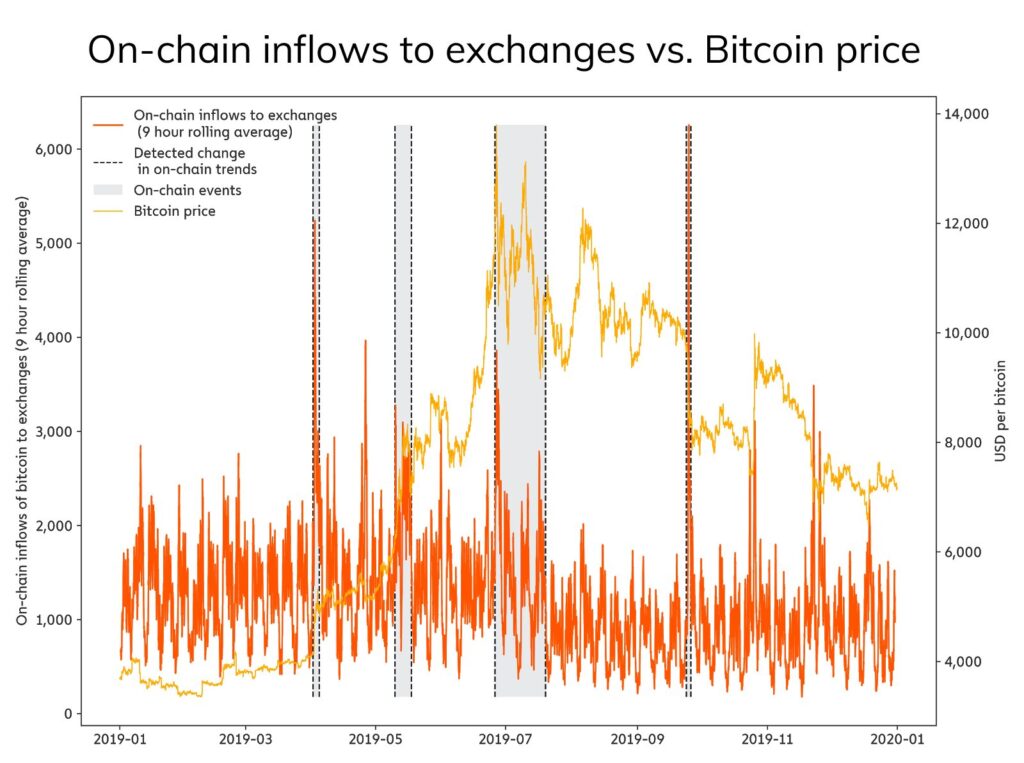
Key Points :
- The on-chain metric known as realised market cap for Bitcoin (BTC) has risen by more than US $8 billion in one week, pushing the figure over US $1.1 trillion, signalling strong inflows from investors and miners.
- The inflows are attributed largely to corporate treasury allocations and ETF vehicles, but buying by major channels (ETF sponsors and MicroStrategy) has slowed — which may limit near-term price upside.
- Institutional buying via ETFs is improving: inflows of about US $931 million in a recent week have lifted year-to-date ETF inflows to US $30.2 billion, but this still trails the prior year and shows demand is not yet ramping aggressively.
- Miner expansion and rising hash rate are cited as long-term bullish signals for Bitcoin’s “money vessel” capacity — essentially the total capital embedded in the network and its infrastructure.
- However, investor sentiment remains muted following a recent approx. US $19 billion crypto market crash, and analysts at Bitfinex argue that unless ETF flows increase to US $10-15 billion and interest rate cuts materialise from the Federal Reserve (Fed), BTC may remain range-bound.
1. Understanding the “Money Vessel” – Realised Market Cap as a Demand Signal
The phrase “money vessel” has been applied to Bitcoin to capture the idea that as more capital flows into the network — via holders retaining coins, treasuries accumulating BTC, and miners continuing operations — the network becomes a larger vessel for stored value. According to on-chain analytics by CryptoQuant’s founder Ki Young Ju, the realised market cap of Bitcoin (i.e., the sum of all coins valued at the price when they last moved) has climbed above US $1.1 trillion after a one-week increase of roughly US $8 billion.

This metric is arguably a deeper measure of ‘investment commitment’ than simple market capitalisation, which simply multiplies current supply by current price. Realised cap reflects the price at which each coin last moved, hence it integrates actual historical buying events rather than just current valuation. This suggests that the network is absorbing fresh capital rather than simply benefiting from speculative price revaluation.
For investors seeking new crypto-asset opportunities, this metric underscores that Bitcoin is increasingly viewed not just as a speculative instrument, but as a durable store of value — which in turn may anchor the broader ecosystem and provide a stable base for other move-and-improve protocols.
2. ETF Flows: Resurgence But Not Yet a Breakout
While the underlying capital in the network is growing, the visible institutional channel of exchange-traded funds (ETFs) tells a more nuanced story. Recent data show that weekly inflows into Bitcoin investment products reached approximately US $931 million, bringing the year-to-date total to around US $30.2 billion. However, this figure still lags last year’s inflows (cited as around US $41.6 billion) and indicates that institutional momentum has not yet surged to new peaks.

Moreover, analysts point out that though inflows are positive, some major ETF buying channels appear to have decelerated. According to Ki Young Ju, demand is now “driven mostly by ETFs and MicroStrategy, both slowing buys recently.” For crypto investors seeking next-generation tokens or protocols with growth potential, this suggests that the “big umbrella” asset (Bitcoin) may need renewed institutional impetus to unlock broader ecosystem sentiment and capital rotation.
3. Miner Activity & Network Expansion: The Long-Term Bull Case
Beyond fund flows, infrastructure activity is also contributing to Bitcoin’s narrative as a value vessel. The hash rate (a proxy for miner commitment and network security) is rising, and large mining firms are reportedly expanding their ASIC-hardware deployments. This increased infrastructure investment is seen as a bullish long-term signal: more miners indicate faith in the network’s sustainability, and they add to the aggregate value framework of Bitcoin.
From a practical applications vantage—particularly relevant to your interest in blockchain and asset-backed systems—this shows that Bitcoin remains the backbone of the decentralised value layer, which in turn gives confidence to adjacent layers and protocols. The stronger this base becomes, the more credible become layers built for swaps, payments, or “asset-backed representation” as you frame it in your white paper.
4. Macro & Sentiment: The Missing Momentum for a Breakout
Despite these positive signals, the broader picture is one of cautious optimism. Investor sentiment remains weak following a major draw-down of approximately US $19 billion in the crypto markets. Analysts at Bitfinex note that unless two key drivers emerge—(1) ETF inflows reaching US $10-15 billion and (2) meaningful rate cuts by the U.S. Fed—Bitcoin’s upside could be capped around USD $140,000.
Specifically, the base scenario they model suggests that if ETF flows accelerate and two Fed rate cuts materialise in Q4, Bitcoin might traverse toward the USD $140K region. But absent that, the scenario may remain one of stagnation or range-bound movement. This tone is consistent with other on-chain analytics suggesting that while inflows are present, the “fund flow ratio” (a measure of exchange inflows/outflows vs total network activity) has hit historic lows, implying that while capital is committed, active trading demand is muted.
For a developer and ecosystem strategist—such as yourself—the implication is that while the foundation is steady, the environment for breakout growth (and capital rotation into newer protocols) may only open once institutional or macro triggers fire. Until then, altcoins and layer-two innovation may need to rely more on structural fundamentals (velocity, developer activity, utility) rather than capital mania alone.
5. Implications for New Assets, Income Sources & Blockchain Use Cases
Given your interest in new crypto assets, income-generative opportunities, and practical blockchain applications, here are key take-aways:
- Asset‐backed value layer is strengthening: Bitcoin’s rising realised cap suggests that it increasingly functions as a reserve of value. This in turn provides a more solid foundation for complementary systems (for example, tokenised real-world assets or “asset-backed representation” layers) that rely on a robust base network.
- Institutional stimulus is lagging but poised: The current slow but positive ETF inflows mean that broader market uplift is possible but not guaranteed. For altcoins or new tokens, this implies that momentum may not come purely from macro/ETF channels — those looking for the “next move” should anchor on utility, uptake, and niche talent rather than expecting passive flow to drive everything.
- Infrastructure expansion matters: Miner investment and network activity are non-speculative signals. For blockchain applications, this logistic layer is critical. When the foundational network strengthens, derivative uses (swaps, payments, tokenised assets) become more feasible and credible.
- Sentiment and macro remain risk factors: Rate‐cut expectations, macro clarity, and regulatory signals are still major determinants. For income vehicles (e.g., staking, yield strategies) built on newer protocols, risk assessment must account for the possibility of sideways movement in the base asset as institutional demand remains in wait.
- Rotation potential into altcoins: As one analyst noted, while Bitcoin offers “peace” and stability, selects altcoins (e.g., those with real developer activity, utility and money flows) may capture the “velocity” and upside. For someone building wallet infrastructure or swap UX (as you are), this suggests that enabling flexible access to both stable base assets and dynamic alt-protocols remains important.
Conclusion
In summary, Bitcoin’s on-chain metrics show strength: the realised cap surge above US $1.1 trillion and recent inflows highlight that Bitcoin continues to accumulate value and remains the primary “money vessel” in the crypto space. Yet, institutional channels (notably ETFs) show only modest momentum compared to prior peaks, and macro conditions (rate stimuli, regulatory clarity) will likely determine whether this base translates into a broader market breakout. For practitioners focused on new crypto assets, income opportunities and blockchain use cases, the current regime suggests a stable base but not an explosive leap — meaning the rewards may favour those who apply structural fundamentals, build utility and anticipate the next wave of capital rather than rely solely on passive momentum.

